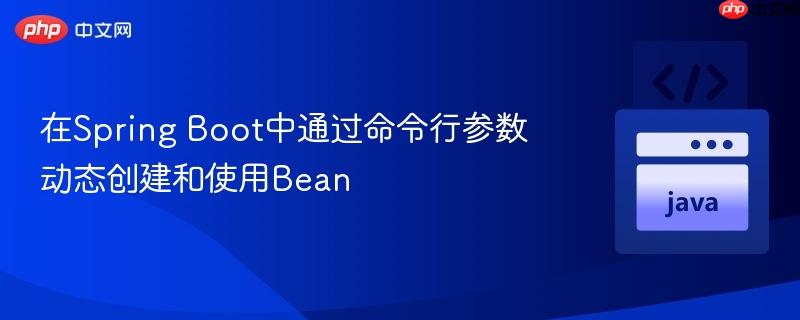
本文详细介绍了如何在spring boot应用中,利用`applicationrunner`和`genericapplicationcontext`,将命令行启动参数动态注册为spring bean。通过实例代码演示了如何获取参数、注册不同类型的bean,以及如何在应用的其他部分通过`@autowired`或`applicationcontext`获取并使用这些动态bean,并提供了测试方法和最佳实践,以增强应用的灵活性和可配置性。
在Spring Boot应用开发中,我们经常需要根据应用启动时的外部参数来调整程序的行为。例如,在批处理任务或需要动态配置的场景下,通过命令行参数传递配置信息是一种常见且有效的方式。本文将深入探讨如何在Spring Boot中优雅地获取命令行参数,并将这些参数动态地注册为Spring Bean,进而使其能够在应用的任何位置被方便地注入和使用。
在深入实现之前,我们首先了解几个关键的Spring Boot组件:
以下是如何在Spring Boot应用中,将命令行参数动态注册为Bean的具体实现步骤。
首先,我们需要创建一个实现ApplicationRunner接口的Spring Boot主应用类,并注入GenericApplicationContext。
import org.springframework.boot.ApplicationArguments;
import org.springframework.boot.ApplicationRunner;
import org.springframework.boot.SpringApplication;
import org.springframework.boot.autoconfigure.SpringBootApplication;
import org.springframework.context.support.GenericApplicationContext;
import org.springframework.beans.factory.annotation.Autowired;
@SpringBootApplication
public class DynamicBeanApp implements ApplicationRunner {
@Autowired
private GenericApplicationContext context; // 注入通用应用上下文
public static void main(String[] args) {
SpringApplication.run(DynamicBeanApp.class, args);
}
@Override
public void run(ApplicationArguments args) throws Exception {
// 获取原始的命令行参数数组
String[] rawArguments = args.getSourceArgs();
System.out.println("检测到命令行参数:");
for (String arg : rawArguments) {
System.out.println(" - " + arg);
// 稍后我们将在这里注册Bean
}
// 示例:调用其他组件的方法
// myService.performTask();
}
}在上述代码中,ApplicationRunner的run方法会在应用完全启动后执行。args.getSourceArgs()方法返回一个字符串数组,包含了所有未解析的原始命令行参数。
在run方法中,我们可以遍历获取到的命令行参数,并使用GenericApplicationContext的registerBean方法将它们注册为Spring Bean。
import org.springframework.boot.ApplicationArguments;
import org.springframework.boot.ApplicationRunner;
import org.springframework.boot.SpringApplication;
import org.springframework.boot.autoconfigure.SpringBootApplication;
import org.springframework.context.support.GenericApplicationContext;
import org.springframework.beans.factory.annotation.Autowired;
@SpringBootApplication
public class DynamicBeanApp implements ApplicationRunner {
@Autowired
private GenericApplicationContext context;
public static void main(String[] args) {
SpringApplication.run(DynamicBeanApp.class, args);
}
@Override
public void run(ApplicationArguments args) throws Exception {
String[] rawArguments = args.getSourceArgs();
System.out.println("开始动态注册Bean...");
for (String arg : rawArguments) {
// 为每个命令行参数注册一个Bean
// 这里以注册一个简单的Object类型Bean为例,Bean的名称即为参数值
// 实际应用中可以根据参数值创建更复杂的业务对象或配置对象
context.registerBean(arg, Object.class, () -> new Object());
System.out.println("已注册Bean: '" + arg + "' (类型: Object)");
}
System.out.println("Bean注册完成。");
}
}context.registerBean(beanName, beanType, beanSupplier)方法允许我们:
注意事项:
一旦Bean被注册到Spring容器中,就可以像其他Spring Bean一样被注入和使用了。
你可以在任何需要使用这些动态Bean的组件中注入ApplicationContext,然后通过Bean的名称获取。
import org.springframework.context.ApplicationContext;
import org.springframework.beans.factory.annotation.Autowired;
import org.springframework.stereotype.Component;
@Component
public class MyService {
@Autowired
private ApplicationContext applicationContext;
public void useDynamicBeans() {
System.out.println("\n--- MyService 正在使用动态Bean ---");
try {
// 假设命令行参数注册了 "foo" 和 "bar"
Object fooBean = applicationContext.getBean("foo");
System.out.println("获取到Bean 'foo': " + fooBean.getClass().getName());
Object barBean = applicationContext.getBean("bar");
System.out.println("获取到Bean 'bar': " + barBean.getClass().getName());
} catch (Exception e) {
System.err.println("获取动态Bean失败: " + e.getMessage());
}
}
}如果Bean的名称是已知的或可预测的,可以直接使用@Autowired结合@Qualifier进行注入。
import org.springframework.beans.factory.annotation.Autowired;
import org.springframework.beans.factory.annotation.Qualifier;
import org.springframework.stereotype.Component;
@Component
public class AnotherService {
@Autowired
@Qualifier("foo") // 注入名为 "foo" 的Bean
private Object fooBeanFromCmd;
@Autowired
@Qualifier("bar") // 注入名为 "bar" 的Bean
private Object barBeanFromCmd;
public void displayInjectedBeans() {
System.out.println("\n--- AnotherService 正在使用直接注入的动态Bean ---");
if (fooBeanFromCmd != null) {
System.out.println("直接注入的Bean 'foo': " + fooBeanFromCmd.getClass().getName());
}
if (barBeanFromCmd != null) {
System.out.println("直接注入的Bean 'bar': " + barBeanFromCmd.getClass().getName());
}
}
}为了让这些服务被调用,你可以在DynamicBeanApp的run方法中注入并调用它们:
// ... (DynamicBeanApp 顶部代码不变)
@Autowired
private MyService myService;
@Autowired
private AnotherService anotherService;
@Override
public void run(ApplicationArguments args) throws Exception {
String[] rawArguments = args.getSourceArgs();
System.out.println("开始动态注册Bean...");
for (String arg : rawArguments) {
context.registerBean(arg, Object.class, () -> new Object());
System.out.println("已注册Bean: '" + arg + "' (类型: Object)");
}
System.out.println("Bean注册完成。");
// 调用服务以使用动态Bean
myService.useDynamicBeans();
anotherService.displayInjectedBeans();
}
}在单元测试或集成测试中,我们可以使用@SpringBootTest注解的args属性来模拟命令行参数。
import static org.junit.jupiter.api.Assertions.assertNotNull;
import org.junit.jupiter.api.Test;
import org.springframework.beans.factory.annotation.Autowired;
import org.springframework.beans.factory.annotation.Qualifier;
import org.springframework.boot.test.context.SpringBootTest;
import org.springframework.context.ApplicationContext;
// 使用 @SpringBootTest(args = {"foo", "bar"}) 模拟命令行参数
@SpringBootTest(args = {"foo", "bar", "configValue"})
public class DynamicBeanIntegrationTest {
@Autowired
private ApplicationContext applicationContext; // 注入应用上下文
// 直接注入动态Bean
@Autowired
@Qualifier("foo")
private Object fooBean;
@Autowired
@Qualifier("bar")
private Object barBean;
@Autowired
@Qualifier("configValue")
private Object configValueBean;
@Test
void contextLoadsAndDynamicBeansArePresent() {
// 验证通过ApplicationContext获取的Bean是否存在
Object retrievedFoo = applicationContext.getBean("foo");
assertNotNull(retrievedFoo, "Bean 'foo' 应该存在");
Object retrievedBar = applicationContext.getBean("bar");
assertNotNull(retrievedBar, "Bean 'bar' 应该存在");
Object retrievedConfigValue = applicationContext.getBean("configValue");
assertNotNull(retrievedConfigValue, "Bean 'configValue' 应该存在");
// 验证通过@Qualifier直接注入的Bean是否存在
assertNotNull(fooBean, "@Qualifier注入的Bean 'foo' 应该存在");
assertNotNull(barBean, "@Qualifier注入的Bean 'bar' 应该存在");
assertNotNull(configValueBean, "@Qualifier注入的Bean 'configValue' 应该存在");
System.out.println("所有动态Bean均已成功创建并注入。");
}
}通过ApplicationRunner和GenericApplicationContext动态注册命令行参数为Spring Bean,为Spring Boot应用带来了极大的灵活性和可配置性。
优势:
注意事项和最佳实践:
掌握这种技术,能够帮助你构建更加健壮、灵活和易于管理的Spring Boot应用。
以上就是在Spring Boot中通过命令行参数动态创建和使用Bean的详细内容,更多请关注php中文网其它相关文章!

每个人都需要一台速度更快、更稳定的 PC。随着时间的推移,垃圾文件、旧注册表数据和不必要的后台进程会占用资源并降低性能。幸运的是,许多工具可以让 Windows 保持平稳运行。




Copyright 2014-2025 https://www.php.cn/ All Rights Reserved | php.cn | 湘ICP备2023035733号